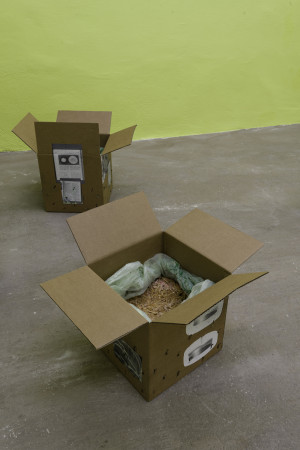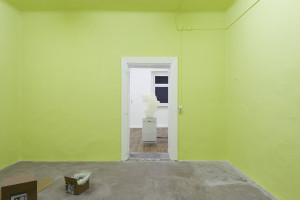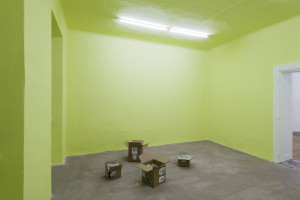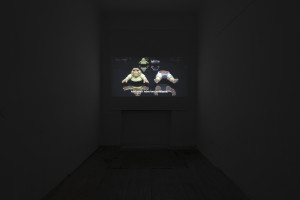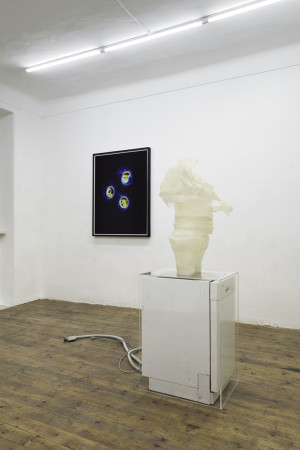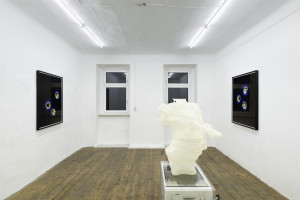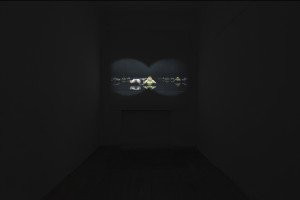Who do “we” become when entities meet? Or, what might it take to escape the humanist territory?
Kosmo stages a theatre, or field of negotiation of polyphon cosmovisions and hybrid experiences that aim to disturb rationalist and humanist textures, with the seeming magical, ungraspable, monstrous and irrational.
Testing out, stripping down and re-constructing belief systems with ancient and contemporary mysticism, evolves a variety of subject positions. How can we imagine a point of view that is beyond what we conceive as “self” and “other”? Would it be possible to overcome an anthropocentric perspective and imagine new global ecologies that invite all entities, visible and invisible to denounce one’s own epistemological and ontological limitations?
“Bringing into disclosure an ingredient that both belongs to the territory and connects with an outside against which this territory protects itself,” the works in this exhibition aim to challenge boundaries such as inside/outside, self/other, scientific/supernatural for embodied positions of “us” – as borderliners of sorts.
Situated within accelerated processes of commodification of all organisms and genomes, human and non-human, “natural” and “artificial” species, KOSMO wants to stage zones of contact as locus of conflict and becoming with. Hybrid spaces of transformation might encourage poriferous borders in the position and vision of the subject, and with it of governing ideologies and ideas of reality based in humanist heritage and its forms of experience and representation.
Donna J. Haraway, When Species Meet, 2007
Isabelle Stengers, Experimenting with Refrains: Subjectivity and the challenge of escaping modern dualism, 2008
Covering the walls in flamboyant yellow paint of poisonous snake venom, Marguerite Humeau’s Black Mamba (2015) conveys a lethal presence of this animal and is demanding a particularly cautious moving through the space. Of alarming visual and bodily presence, this protagonist of ancient, not only indigenous but also Christian, mythology is capable of collapsing the human body in less than 45 minutes, while its venom is also one of the most popular ingredients for anti-aging creams and fantasies of eternal youth and life. Echoing through this room that is inhabited by the both real and spiritual presence of the serpent, in That goddess (2014) a female voice performs an ancient Egyptian song by Cleopatra – or rather the resurrection and speculation on what this Egyptian goddess might have sounded like – in seven partly distinct languages such as Ge’ez, Median, Ancient Hebrew or Troglodyte. Interweaving scientific research, technology, contemporary myth, occult and fiction, Humeau brought into existence the otherworldly ghost of this goddess of love and eternal life, creating a space that is about the absence of knowledge while posing contemporary modes of reality as a distinct mode of existence that is becoming increasingly irrelevant.
Spread throughout the room are four carton boxes with different types of Oyster mushrooms that will grow through the duration of the exhibition – Yellow, Pink, King and Grey Oyster – in a series titled Primordia#Formation (2016) by artist duo The Mycological Twist composed of Anne de Boer and Eloise Bonneviot. A DIY recycling farm of this species able to decompose and transfer toxic chemicals and plastic within their elaborate systems of information in circulation, carrying instructions on how to grow and spread the spores, this work is both a post-human proposition to a cleansing of the man-made planet and ecology, as a socio-ecological experiment.
Resembling the torso of an ancient Greek sculpture, Antoine Renard’s 3D rendered figure Untitled (2840178_Terror Mum) (2016) inhabits and blocks the path into the space like a guardian. Slightly misfigured, the technologically made shape derives from a human scan sourced online (a scanned body of a US housewife holding a gun). A machine weapon in its hand, this sculpture poses a manifestation of a fragile emergence from digital into physical presence. Positioned on a used dishwashing machine that represents the domestic realm, the warrior of sorts speaks to violence, war, terror threat, and misuse of technology imbued in the mindset on the everyday as much as a struggle of a being of its own rights that it yet has to fight for and novel life and death circles of man-made ecologies and their and renewal.
In the Unseen Potential (2013) series, Jeremy Shaw employs the obscure form of Kirlian photography to record a series of experiments attempting to reveal the hidden energies of plants with psychotropic properties. Kirlian photography is a contact-based process used to capture the phenomenon of electrical coronal discharges that naturally occur around objects – considered by some to be their aura. The psychedelic (Yopo Anadenanthera Peregrina) seeds are placed directly on an unexposed piece of Polaroid land-film situated on the copper plate surface of a Kirlian camera device and ignites a high voltage charge from within it – sending an electric shock through the film and into the plant. The process captures a photographic image of both the plant and the unseen electrical coronal discharge that exists around it. Coincidentally (or perhaps, ironically), these attempts to record the hidden energy of plants with the potential to incite psychedelic experiences have resulted in images that fall under the canon of ‘psychedelic’ themselves.
In a video starring Baby Sinclair by Andrew Norman Wilson, titled Unthinkable Bygone (2015), a divided corpse of this technologically rendered creature finds itself within a mirror cabinet of multiple reflections as a kind of mise-en-abyme. As the world of the narrator collapses with the world of the character and as the boundaries of images-within-images are not identifiable, emerges the potential for the viewer to identify with the simulated camera or object view, they are still left without the possibility of obtaining any truth. The question of what Baby Sinclair is or in which world he exists, becomes a question for the viewer of who she or he and demarcates a shift from epistemological towards ontological questioning on objectification of the self and subjectification of the other.
This Transition Will Never End (2008-ongoing) by Jeremy Shaw is an ongoing archive of appropriated footage taken from a wide variety of movies and television in which a vortex, or any such tunnel-like or spiraling image, is used to represent the slippage of time or a transition from one reality to another. Again dealing with the idea of the representation of something thus far undocumentable, Shaw catalogues the illustrations of this ubiquitous phenomena and notes the apparent agreement that has been reached from extremely low budget movies to Oscar winning Hollywood films. This Transition Will Never End also serves as a history of special-effects via this trope of representation; from physical constructions (The Time Tunnel, 1958) through to split-screen animation (2001, 1968), early computer graphics (Tron, 1982) to highly advanced contemporary CGI (Enter the Void, 2008).

